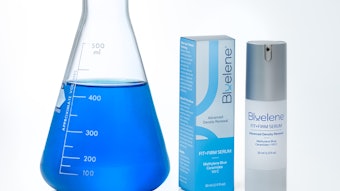
The cosmetic industry is undergoing the next truly massive investing opportunity. Lately, more and more biotech companies are entering a field they call “proteomics," a large-scale study of proteins, which is pivotal in understanding and engineering biological processes. This approach is set to lead the next frontier in biology-first engineering in skin care science and hair biology.
The Role of Proteins in Skin Health
Skin is the largest human organ standing at the interface with the outside world, it is subject to lifelong exposure to several environmental factors and in doing so, provides the body with a fundamental shield to environmental stress and overall protection. Within this intricate defense system, proteins act as the building blocks and orchestrators, ensuring the resilience and functionality of the skin amid challenges.
Proteins are the most diverse and structurally complex macromolecules composed of amino acids and participate in nearly every known aspect of life, either directly or by synthesizing other active biomolecules. Inside our body, billions of tiny biological nanomachines called proteins are hard at work. They play crucial roles in various biological processes, including skin health and function. Proteins serve as the structural support of cells and tissues as well as regulating cellular processes, including those involved in initiating programmed cell death (apoptosis) when necessary for the health and functioning of the organism.
Their job depends on the unique 3D shapes they're born with. These shapes can change because of mutations or damage from environmental factors, which can impact their function. when chemicals harm them. These special 3D shapes make sure that new protein chains fold correctly and existing proteins stay in their proper shape, even when things get tough.
A Proteome-Centric View of Aging
 Inside our body, billions of tiny biological nanomachines called proteins are hard at work. They play crucial roles in various biological processes, including skin health and function.primipil at Adobe Stock
Inside our body, billions of tiny biological nanomachines called proteins are hard at work. They play crucial roles in various biological processes, including skin health and function.primipil at Adobe Stock
The proteome comprises all the proteins (collagen, elastin, keratin, fibrillin, laminin, filaggrin etc.) in a cell or living thing. When proteins fold incorrectly, they’re more likely to get damaged by oxidation, this messes up how they work, making it harder for them to do their jobs right.
Skin aging is a fascinatingly complex phenomenon that covers chronological factors and extrinsic factors. Skin undergoes constant changes, with the capability to repair its components once damaged. Even though the skin forms a strong barrier against external harm, it can be overwhelmed by environmental stressors, compromising its ability to protect.
Besides environmental factors, skin aging is a continuous, complex and cumulative biological process influenced by intrinsic - due entirely to the passage of time and extrinsic - which is under the influence of environmental factors.
Ultraviolet radiation and pollutants contribute to skin aging and functional decline inducing harmful oxidative modifications of macromolecules and stress-related skin disorders. Aging also slows down the skin’s abilities to maintain homeostasis and repair, contributing to the aging process.
Environmental stressors will impact first our skin proteins, due to their abundance and reactivity. Skin functions are largely controlled by proteins. Studying these proteins, called proteomic analyses, can offer valuable insights into how our genes and lifestyle affect our skin. By understanding the proteome and environmental factors, we can develop personalized skin care treatments based on these insights to tackle mechanisms of aging.
Oxidatively-Damaged Proteins
 When a cell is under conditions of stress, such as oxidative stress and UV exposure, the proteins can become damaged, resulting in the formation of carbonyl groups on the side chains of amino acids.23 Audiovisual at Pexels
When a cell is under conditions of stress, such as oxidative stress and UV exposure, the proteins can become damaged, resulting in the formation of carbonyl groups on the side chains of amino acids.23 Audiovisual at Pexels
Further, accumulation of carbonylated proteins has a negative correlation with skin moisture functions consisting of the water content and trans-epidermal water loss (TEWL). It has also been reported that carbonylated proteins in dry skin in the winter season can be seen at a higher frequency compared with the summer season, indicating that carbonylation extensively affects skin conditions.
In addition, during periods of cellular stress and recovery, proteins experience the most widespread impact among macromolecules. It is scientifically proven that increased proteome damage, especially protein carbonylation, correlates with biological age. Carbonylated proteins can form aggregates and accelerate skin aging.
The New Frontier of Longevity: Proteomic Research
Proteomics is closely related to genomics. While the latter is concerned with our DNA; proteomics is all about proteins.
Proteomics is the large-scale study of proteins, their structures, functions and interactions to better understand their functional roles within biological systems. It is a rapidly evolving discipline within the realm of bioinformatics and has become a key area of cellular biology.
Scientists have long known about proteomics’ potential; however, the cost and complexity of protein detection kept the industry locked inside science labs. There are millions of known proteins and detecting them isn’t easy.
However, there have been several breakthroughs over the past year and proteomics is following the same trajectory as genomics. In short, proteomics is one of the most exciting hypergrowth industries in the world today.
Central to this exploration is the recognition that protein carbonylation plays a pivotal role in aging and age-related degeneration. When cells encounter damage, their immediate priority is not repairing DNA, but rather safeguarding their proteins. Protecting the proteome from oxidative damage is essential for ensuring the cell's survival, as active proteins are critical for initiating DNA repair and synthesizing new proteins.
Ongoing research in understanding the proteome opens up avenues for gaining deeper insights into skin biology and longevity. It is directed toward uncovering the advantages associated with enhancing the protection of the proteome against environmental stressors, aiming to unlock further avenues for cellular resilience and longevity. It enables the identification of key biomarkers that indicate skin health or issues and facilitates the development of skin care products that are more tailored for targeted solutions and efficient in addressing specific concerns.
Protein-based Beauty Driven by Novel Technology
To explore the latest advancements driving this revolution, let's delve into new state-of-the-art methodologies and techniques. These include optimizing the visualization of skin cells and layers, comparing in vivo, ex vivo, and in vitro analysis methods, and gaining a deeper understanding of complex skin and hair systems.
In clinical laboratories, emerging tools such as biotechnology, machine learning, bioinformatics, and mass spectrometry-based proteomics are employed to identify and screen proteins, thereby determining their characteristics, including the composition type, quantity and charge of amino acids.
Mass spectrometry is predominantly relied upon, utilizing light to ascertain the molecular weight and identity of proteins. Each protein possesses its own unique mass, facilitating its identification. Bioimaging platforms represent the second trailblazing technology that is revolutionizing in vitro studies today, allowing scientists to perform visual tests of a plethora of intracellular mechanisms through increasingly precise technologies.
Impressive advancements on high-content and live-cell imaging technologies, cryo-electron microscopy and super-resolution confocal microscopy have allowed scientists to study skin at unprecedented levels of detail. Using proprietary engineered nanoparticles, automation instrumentation, consumables, and a software suite, businesses can perform deep proteomic analysis at scale in a matter of hours.
To investigate how particular proteins regulate biological processes, researchers usually require a means of manufacturing functional proteins of interest. Overall, these technologies enable comprehensive analysis of protein expression patterns and their functional implications in response to treatments and stress exposures, providing insights into the molecular mechanisms underlying cellular responses.
This paves the way for new investigations and groundbreaking discoveries facilitated by the utilization of advanced data-analysis and parameter-detection tools in the development of various active ingredients and formulations. What we are seeing right now is a convergence of many novel approaches coming together and making it possible to do proteomics at a scale, output, speed, and sensitivity that simply was not possible before.
Emerging Efficacy Testing Methods
 With the surge in biotechnology and alternative methods in claim substantiation testing, a new wave of testing houses has emerged, revolutionizing the landscape of efficacy testing for innovative market-leading claims.wayhome.studio at Adobe Studio
With the surge in biotechnology and alternative methods in claim substantiation testing, a new wave of testing houses has emerged, revolutionizing the landscape of efficacy testing for innovative market-leading claims.wayhome.studio at Adobe Studio
These modern facilities leverage cutting-edge biotechnological approaches, allowing for more efficient, cost-effective, and accelerated testing processes. The integration of advanced technologies not only reduces financial burdens on brands but also facilitates the delivery of stronger and more ambitious claims.
In vitro assays can be classified as cell-based (i.e., testing ingredient effects on the release of a biomarker from a relevant cell type) or cell-free (i.e., testing ingredient effects on enzymatic or chemical reactions, or receptor binding). In skin care research, many cell-based assays use human epidermal keratinocytes or human dermal fibroblasts as these are cell types that make up the various layers of the skin.
Human cell cultures (including keratinocytes and fibroblasts) and human skin and hair strands can be included in personalized in vitro and ex vivo/explant skin studies.
- Provital is committed to pushing ingredients’ efficacy through advanced research techniques. An ongoing focus on collateral knowledge needed for expanded in vitro capacities such as super-resolution confocal microscopy, high-throughput microscopy, proteomics, in-house gene expression arrays, high-throughput measurements and the algorithms that help them achieve access to quantitative information from cellular images. Provital invests significantly in developing 3D skin models within its own laboratories, allowing for more accurate and comprehensive skin research.
- Oxiproteomics is a biotech company specialized in protein quality assessment providing solutions for efficacy validation, from screening up to clinical studies of active Ingredients and finished products. Oxiproteomics patented technologies are based on the direct and specific detection of functional high-quality proteins vs. oxidatively damaged (carbonylated) proteins in biological samples. They engineer an optimized process of protein analyses adapted to different biological samples allowing for the collection of large sets of results and thinking about data interactively, in real-time and dynamically. They offer a unique capability to craft a compelling scientific narrative around proteome protection and repair. This advanced approach enables businesses to make sophisticated claims that surpass what traditional testing houses can achieve. Oxiproteomics explores the intricate details of responses within the proteome, offering a more nuanced understanding of the efficacy of products.
Active ingredient or finished formula screening
Products are evaluated by assessing their impact on living cells like keratinocytes, fibroblasts, melanocytes, and sensitive neurons. By measuring the amount of carbonylated proteins in these cells using a technique called fluorimetry, this helps identify which products are most effective for further, in-depth studies on their efficacy.
In situ visualization of molecular damage protection
In situ labeling and fluorescence imaging is used to detect carbonylated proteins, which indicate oxidative damage. By attaching special fluorescent markers to these proteins, we can get a clear picture of where oxidative damage is happening. This helps us see not only how much damage there is at the molecular level, but also where it's happening within different layers of the skin. This method allows us to see how well our active ingredients and final products protect cells from oxidative damage.
In situ visualization of key biomarkers (skin structure and function)
High-resolution fluorescence imaging is used to further understand the effect of active ingredients or finished products on key protein biomarkers involved in skin structure and function on distinct anatomic compartments.
Quantification of molecular damage protection
They determine the effectiveness of active ingredients or finished products by calculating a score that measures how well they protect cells. This score is derived from measuring the absolute amount of carbonylated proteins in the cells, adjusted by the total amount of proteins present.
- Olink is committed to achieving a new era of precision through a proteomics-driven understanding of human biology. Dedicated to innovation, quality, and transparency. Olink provides advanced products and services for protein biomarker discovery.
- Shiru uses AI to optimize the discovery, development and scale up of proteins for personal care and other industries and recently launched the ProteinDiscovery.ai marketplace, featuring 33 million molecules/protein sequences.
Protein-based Beauty Ingredient Development
Personal care brands and formulators are increasingly drawn to the allure of a myriad of innovative businesses that offer diverse products, services, and platforms. Among these offerings are high-tech ingredients, including emerging biotech proteins, which are revolutionizing the industry.
- Activen, a biotech company that has pioneered a new class of actives for the dermo-cosmetic industry and led the research on Miniproteins. Miniproteins are a new class of active cosmetic ingredients; proteins that are long enough to fold into a stable 3D structure yet small enough to penetrate the skin, therefore offer high and specific efficacy on a given target. Activen is a pioneer in this field and has developed a unique database of more than 100,000 miniproteins to date.
- Through Modern Meadow’s Bio-F@rm platform, the company has transitioned its focus to protein application spanning beauty, biomedical, and biomaterials sectors. Their 100% human collagen replacement holds significant promise in dermatology and topical skin care, supported by a robust system for engineering fermentation-based proteins at scale to address diverse needs. Already embraced by some of the world’s most discerning brands, Bio-Coll@gen is spearheading future innovations in the field.
- Leveraging a biotech platform, Geltor purposefully designs molecules by tapping into computational databases of known protein sequences from nature. They meticulously select and optimize amino acid sequences to deliver superior performance, novelty, and sustainability. Genetic engineering forms the core of their biodesign approach, empowering them to create proteins that offer novel and superior performance while employing more sustainable processes and avoiding animal inputs. Geltor's microorganism demonstrates intelligence and efficiency, swiftly creating and replicating the desired protein. With their proprietary technology platform, Geltor brings novel proteins to market with unmatched speed and accuracy.
- Lipotrue continues to redefine innovation in the beauty industry, showcasing their latest breakthrough with an exceptional line of protein fragments. Among the newest additions are the Remastered Fragments and Col-4-Frag remastered. These groundbreaking products include a sustainable, biomimetic collagen IV fragment cultivated in wild plants through vertical farming, preserving the beauty of the V-neckline by enhancing the collagen IV network. Utilizing cutting-edge techniques such as immunostaining and microscopy with human skin explants, Lipotrue rigorously tests the efficacy of ingredients like Versillin, ensuring optimal results thus offering advanced market-leading claims.
Another big-league player in the field of biotechnology, Ginkgo Bioworks stands at the forefront of cell programming, offering a flexible end-to-end platform that addresses challenges across various sectors, including specialty chemicals, pharmaceuticals, and agriculture. Tailoring partnerships to match the developmental stage of partners’ products, Ginkgo provides customized R&D services ranging from strain engineering to fermentation optimization. Through Ginkgo’s protein services, the team utilizes metagenomic discovery and computational design to design, screen, and optimize a library of novel proteins, supporting partners’ R&D efforts. Throughout the process, Ginkgo selectively screened promising proteins with further high-performance, application-specific characterization to inform the final down selection.
It offers four distinct modules of work designed to support our customers at every stage of the protein expression process within their R&D cycle:
- Host evaluation: Evaluate and compare host strain with their suite of hosts.
- Strain optimization: Enhance strain through genome modifications, improving quality, functionality, and titer.
- Classical strain improvement: Employ non-GM approaches to enhance titers further.
- Scale + fermentation: Utilize in-house pilot and commercial scale fermentation facilities to enhance production efficiency.
Optimizing production hosts is paramount for facilitating the fermentation of proteins. This intricate process involves tasks such as protease elimination, chaperone introduction, promoter creation, and expression system tailoring to meet each protein's specific requirements. Additionally, it encompasses design, downstream processing, and scaling efforts.
Successfully navigating the journey of bringing a protein to market is complex. By leveraging Ginkgo’s expertise, businesses can access rapid and scalable solutions. From host selection to optimizing host strain development and scaling, Ginkgo Protein Services empowers businesses to overcome bottlenecks, reduce capital expenditure, expedite development, and mitigate R&D risk. Over the years, Ginkgo has honed its ability to integrate diverse computational and experimental technologies, enabling them to effectively address complex customer innovation needs.
Ginkgo concluded a collaboration with Cambrium, a leading German start-up specializing in applying generative AI to protein design and synthesis. Through this partnership, both entities combined their expertise to facilitate the rapid and cost-effective design of high-performing, industrially relevant microbes for protein production.
Leveraging Ginkgo’s ultra high-throughput screening capabilities and nanoliter-reactor technology, they were able to generate a vast quantity of data linked to specific phenotypes, which served as valuable input for machine learning algorithms. Through this collaboration, they were able to introduce a novel concept of strain engineering. As a result, Cambrium has successfully developed NovaColl, a novel class of collagen active, poised to revolutionize skin care innovation.
The Significance of Proteomic Analysis
Stemming from a profound understanding of skin damage, protein technology research is currently thriving, leading to new discoveries.
For the first time, organizations and research centers have employed technologies capable of detecting, analyzing, and quantifying oxidatively damaged proteins in human skin explant cultures and human skin cell cultures. This enables the unveiling of specific damage mechanisms caused by different environmental stressors, offering novel solutions for efficacy testing a breakthrough technology aimed at significantly identifying and mitigating the causes and effects of aging.
Proteomics stands at the forefront as a pivotal tool for developing and assessing innovative cosmetic products. Protein-based technology holds substantial importance in the cosmetics industry, with ongoing innovations revolutionizing skin and hair health through biologically designed products.
Revolutionizing Skin and Hair Care Innovation
While the cosmetic industry has largely focused on developing products that enhance the appearance of the skin and hair, there is growing interest in identifying ingredients that can also support the natural biological functions and ability to adapt to internal and external stressors using advanced technologies.
As biology increasingly intersects with cosmetics, innovators are learning from the code of life to engineer performance at the protein level. Hi-value Ingredients and formulations engineered to protect and reverse the root causes of aging and damage.
Brands such as K18 are revolutionizing hair care with their innovative products by scanning and testing numerous decapeptides that cover the entire keratin proteome to determine their ability to interact and connect. This rigorous process has led to the development of K18Peptide, a true breakthrough in hair care.
Meanwhile, Naos works on a broader biotechnology ecosystem, with its Institut Esthederm Age Proteom Advanced Serum being the 1st serum that durably protects and strengthens the proteome.
Engineering Biology, A Future View of Well-Aging
- Biotechnological advances: Advances in biotechnology have enabled the production of proteins through innovative methods. This allows for the creation of sustainable and biofunctional proteins with specific skin care benefits.
- Customized and tailored formulations: The understanding of individual skin and hair needs is driving the development of personalized cosmetic formulations tailored for targeted solutions. Protein based technology can be tailored to address specific concerns, offering customized solutions for consumers. Growth of platform-based business models accelerating scientific discoveries leads to the development of novel biomarkers, proteins and tools with enhanced efficacy and specific functionalities for cosmetic applications.
- Smart proteins: Integration of smart technologies into cosmetic formulations may lead to the development of proteins that respond to specific environmental conditions or user needs, providing adaptive skin care solutions.
- Multifunctional proteins: Future formulations may focus on multi-functional proteins that offer a combination of benefits. For instance, proteins with antioxidant properties could protect the skin from environmental damage while promoting collagen synthesis for anti-aging effects.
What’s Next: Challenging Creative Boundaries
Science has only scratched the surface to uncover the inner machinations of skin physiology and the technologies available to serve the personal care and beauty industry are changing at lightning speed. Working with biology enables us to reveal an entirely new landscape of aesthetics and performance. I am excited for the innovators and brands who will embrace this creative opportunity and question what is possible. Only by challenging these creative boundaries will we encounter what is possible when design is unbound.
The tunability of proteins will enable products which are biologically aligned, with the ability to repair, not just mask damage. Protein-based technology helps prevent the causes of skin conditions and aging at a cellular level and continues to be a driving force in cosmetic innovation, offering a diverse range of benefits for skin care and hair care. Future developments are likely to be marked by a combination of biotechnological advancements, sustainability considerations, and a deeper understanding of the intricate relationship between proteins and beauty.
About the Author
Mateja Weber is a product innovation/NPD consultant and scientific adviser; contact the author at [email protected].










